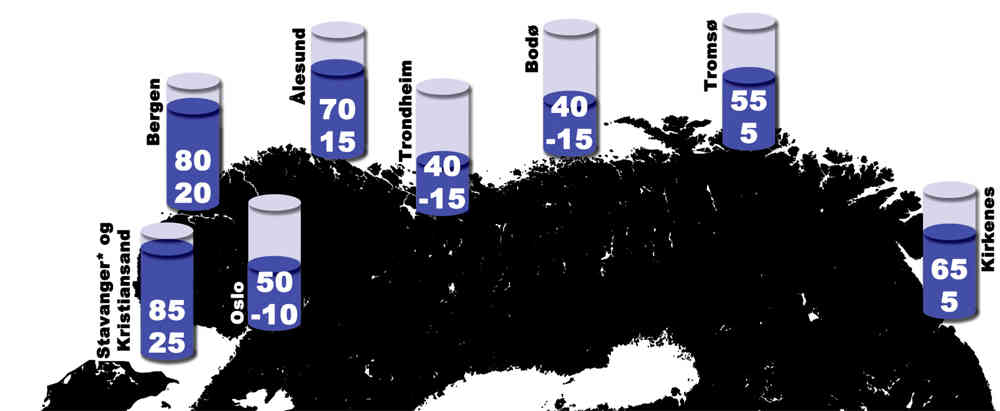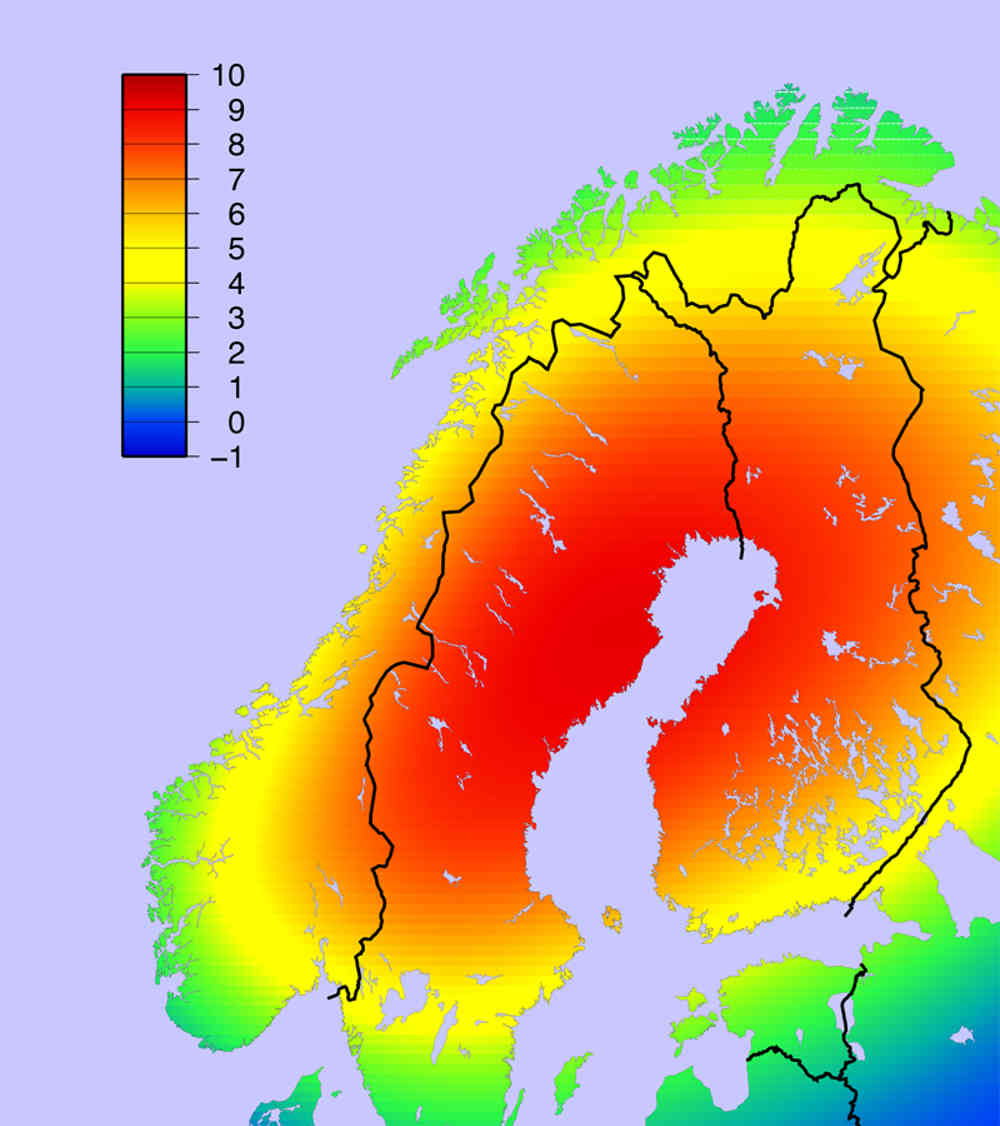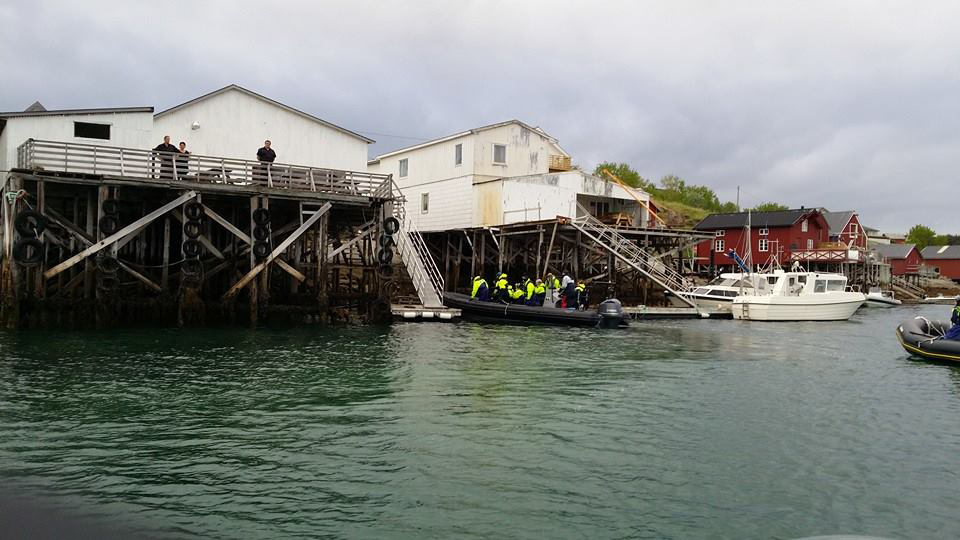There are several reasons why the sea is rising. The two most important ones are that glaciers on land are melting and that the temperature of the water is rising.
When glaciers such as those on Greenland and in Antarctica as well as smaller glaciers around the world melt, the amount of water in the ocean increases.
When the temperature in the sea rises, the water expands. Warm water takes up more space than cold water. The effect of this is greater in deeper seas such as the Norwegian Sea than in shallow seas such as the North Sea and the Barents Sea. This is because deep seas have more water that is being warmed up. However, the circulation in the sea means that the effect of this is distributed in over the continental shelves.
Gravitation pulls water towards land
The sea is not flat, even though it might look as if it is. This is due to gravity. Mass attracts mass horizontally as well. The larger the mass, the greater the gravitational pull. Large landmasses pull more water than smaller landmasses.
This means that there is an impact on the local sea level when large ice masses on land melt away. When, for example, the ice over Greenland is reduced, it reduces the gravitational force so that Greenland exercises less gravitational pull on the surrounding water. In other words, the melt water will not flood the Greenland coastline. Quite the opposite. The sea level around Greenland can fall.
"The melt water will not collect around Greenland, but will be displaced towards areas further away such as around the Equator and in the southern hemisphere. Norway is so close to Greenland that the effect for us will be more or less zeroed out. Melt water from Greenland will therefore not be very significant for Norway. However, should the ice over Antarctica melt, that will have far greater consequences for us", says Jan Even Øie Nilsen, who is a researcher affiliated with the Nansen and Bjerknes Centre.

The estimated probable change in the water level in a 100-year perspective. Stavanger and Kristiansand will likely experience an increase in the water level of between 24 and 85 cm in the next 100 years. The change in Trondheim will be between a 40 cm increase and a 15 cm decrease in the water level. Ill: Drange, Nilsen, Richter and Nesje (2012).
Other factors affecting local sea level changes
Worldwide, an annual sea level rise of 3 mm has been measured. Melt water and the temperature increase in the sea make about the same contribution to the sea level rise.
There are several additional factors that can also lead to higher sea levels, but their effects are more local.
Fresh water takes up more volume than salt water. Where the content of fresh water in the sea increases,this can lead to a higher sea level locally.
If climate changes alter the ocean currents, this will also be significant. A new distribution of warm and cold water will change the sea level locally in the places affected.
Tectonic uplift counteracts rising sea levels

The annual uplift is greatest at the end of the Gulf of Bothnia, where it rises about 1 cm a year. The uplift decreases gradually the further away from the Gulf of Bothnia one moves. Ill: The Norwegian Mapping Authority.
In the ice age, Scandinavia was covered by a thick sheet of ice. This ice cap weighed down the landmass. When the ice disappeared, the pressure lessened and the land rose up again. This tectonic uplift is still incomplete. The landmasses in Scandinavia continue to rise, even though the process is slower than before. The uplift is not the same everywhere. It is most pronounced where the ice was thickest, and slowest where the ice cap was thinnest.
The ice was thickest in the Gulf of Bothnia, and that is where the uplift is fastest. The annual uplift in the Gulf Bothnia is at about 1 cm a year. The speed of the tectonic uplift slows in line with the distance from the Gulf of Bothnia. In Norway, this means that the uplift is most pronounced in eastern Norway and Trøndelag, and least pronounced along the southern, western and Finnmark coast.
Key facts
The Norwegian Mapping Authority measures tectonic uplift with GPS devices and sea level changes with tide gauges.
Tectonic uplift from selected GPS stations in mm/year:
Oslo 5.1 ± 0.33
Stavanger 1.46 ± 0.17
Bergen 2.45 ± 0.36
Trondheim 4.31 ± 0.35
Tromsø 2.9 ± 0.33
Vardø 2.67 ± 0.28
You can find more information about the sea level at the Norwegian Mapping Authority's website: www.sehavniva.no
The process is slow because the mantle beneath the crust, which the ice pushed the land masses down into, is viscous. The speed of the uplift will slow and finally stop when the crust has achieved a new equilibrium. That can take a long time.
"Tectonic uplift will continue for many years, perhaps as much as several thousand years more", says Matthew Simpson, who is a geophysicist in the Norwegian Mapping Authority's geodesy department.
Varying effects
The tectonic uplift means that the sea level will rise less in Norway than in most other countries. As the uplift varies in different parts of the country, the sea level changes will also vary.
The sea level will rise most in southern and western Norway, and along the coast of Finnmark. The areas around the Oslo Fjord, and in Trøndelag and Nordland, will see lower sea level rises.
This video tells you more about the sea level and how to measure it:
